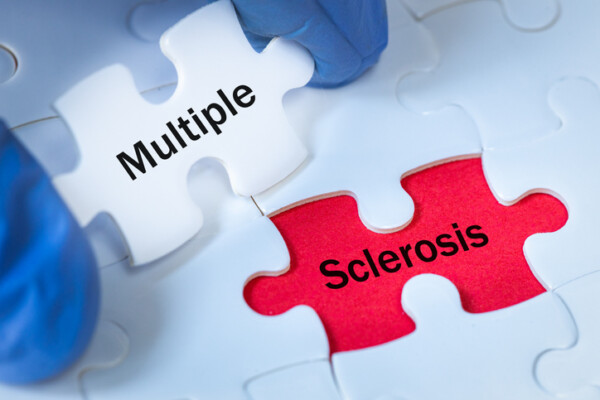By Evelyn Gile, SPT
What is Multiple Sclerosis?
In order to understand the pathology of MS, it is important to understand how nerve cells (neurons) function. Neurons have a cell body with an axon, which looks like a long tail-like projection. The axons assist in sending the nerve signals to the neighboring cells. Axons are also covered in a fatty sheath, named myelin, which assists the cells in transmitting their signals faster and protects the axons from damage.
Multiple sclerosis, or MS, is an autoimmune condition in which the immune system causes inflammation that damages the central nervous system (brain and spinal cord). More specifically, there is a degeneration of the myelin surrounding axons of nerves. This means the signals being sent to other cells is less efficient and the nerves are more likely to become fatigued. The areas of the axon missing the myelin can also become scarred, or fibrotic, which results in further damage of the nerves.
There are four main types of MS. Relapsing-remitting MS (RRMS), which is the most common type, is when there is an occurrence of the immune system damaging the myelin, but it is followed by partial or complete recovery. There is often a cycle of damage followed by recovery. Secondary-progressive MS is when the condition begins as RRMS, but is followed by a decline in nerve function overtime. Primary-progressive MS is when there is a steady decline in nerve function overtime. Progressive-relapsing MS is when there are relapses, similar to RRMS, but there is a progressive decline in function.
Multiple Sclerosis Symptoms
Nerves send different signals depending on where they are in the body. This means that the symptoms someone may experience with MS is dependent on which nerves are damaged. For example, if the nerves that transmit or interpret sensory signals are damaged, one would experience numbness or tingling. Other common symptoms include fatigue, vision changes, weakness, pain, bowel/bladder dysfunction, breathing or speaking difficulties, impaired balance, memory or mood changes, and spasticity (stiffness).
How Physical Therapy Can Help Multiple Sclerosis
Since the symptoms one experiences are unique to them and may vary over time, a multidisciplinary (working with multiple healthcare specialties) approach to managing MS is recommended. Specialties can assist with the management of MS progression, severity, and symptoms. Physical therapy assists with symptom management. A skilled physical therapist can create a plan that is specific to you and the symptoms you are experiencing. They can assist you with creating a physical activity plan that does not increase symptoms of fatigue. They can also assist with symptoms, such as bowel or bladder dysfunction, balance, walking, and spasticity.
Physical Therapy for Multiple Sclerosis in Queensbury & Saratoga
Physical therapy is not just about treating symptoms, it’s about empowering individuals to take control of their multiple sclerosis. By working closely with a skilled physical therapist and adhering to a personalized treatment plan, individuals can manage MS progression, severity, and symptoms, and enhance their overall quality of life. If you or someone you know is struggling with multiple sclerosis, consider the transformative potential of Physical Therapy.
To schedule a physical therapy appointment for multiple sclerosis in Malta, Saratoga Springs, Delmar or Queensbury NY, please call (518) 289-5242.
References
- Tafti D, Ehsan M, Xixis K. Multiple Sclerosis. StatPearls Publishing; 2024.
- The multiple sclerosis process and symptoms. MSAA. May 31, 2022. Accessed July 21, 2024. https://mymsaa.org/ms-information/overview/process-symptoms/.
- Multiple sclerosis (MS). Physiopedia. Accessed July 21, 2024. https://www.physio-pedia.com/Multiple_Sclerosis_(MS).
- Feys P, Giovannoni G, Dijsselbloem N, Centonze D, Eelen P, Lykke Andersen S. The importance of a multi-disciplinary perspective and patient activation programmes in MS management. Multiple Sclerosis Journal. 2016;22(2):34-46.






